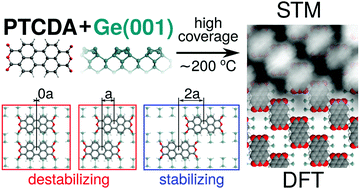Self-ordering of chemisorbed PTCDA molecules on Ge(001) driven by repulsive forces†
Abstract
Realization of future hybrid electronic devices combining organic and inorganic semiconductors requires a well-defined interface between both components. Such an interface can be formed generally by self-ordering of organic molecules on inorganic substrates, which is usually hindered by strong covalent bonds to the semiconductor surface. In this paper, the 3,4,9,10-perylenetetracarboxylic dianhydride (PTCDA) molecules were unexpectedly found to form a locally self-ordered monolayer on a strongly interacting semiconductor surface of the Ge(001). Molecular arrangements with preferential separations between the molecules were observed by the scanning tunneling microscopy at various coverages of the molecules and substrate temperatures, suggesting strong inter-molecular interaction. Atomic structures of two paired molecules and their inter-molecular interaction energies in five different configurations were calculated by density functional theory. Simple Monte Carlo simulations show that mobility of molecules activated only by the inter-molecular interactions is sufficient to reproduce the local self-ordering. A dominant inter-molecular interaction between neighboring chemisorbed molecules has mostly positive energy (destabilizing) except for a single configuration, which leads to the formation of one-dimensional chains of the molecules and finally a periodic two-dimensional array by increasing the coverage.



 Please wait while we load your content...
Please wait while we load your content...